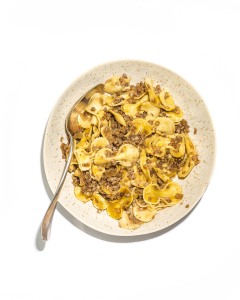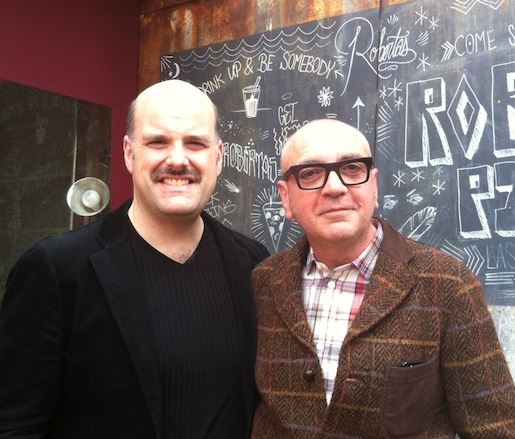Since Bon Appétit recently renewed interest in my family’s Cheese Thing, which then renewed interest in my blog, I’ve decided to revive the sleeping Cook and Eat Better from its mothballed state. (In high school I worked in Ontario’s energy utility, Ontario Hydro, and “mothballing” was what they did to nuclear reactors that were taken offline.) What the heck, I continue to cook and eat better, so maybe there’s a reason to keep sharing more than just an Instagram post or tweet. (Maybe not.)
I’ll take the Cheese Thing enthusiasm to mean that home cooking of homey recipes continues to be popular. And considering since I last posted here I’ve been included on epicurious.com’s list of the 100 Greatest Home Cooks of All Time, and the Forward’s list of the 50 Most Influential Jews in America, I thought I’d rev up the family’s Kasha Varnishkes recipe, thereby killing two lists one groat.
I was honored to be asked to write an ode to KV for Tablet Magazine‘s recent compendium of the 100 Most Jewish Foods.Who am I to argue. Here’s how it begins:
“My husband is a palliative care doctor who helps people with serious illness make critical decisions, often at the end of their lives. Several years ago, I told him he had better learn how to make my family’s kasha varnishkes because they would be among my final requests. A combination of…[READ MORE]”
That ode didn’t include our recipe (my mother never used one). But for those with less of a yiddishkeit culinary gift, here’s my closest approximation for you, adapted from my book, The Mensch Chef:
Davis Family Kasha Varnishkes
Makes 2 quarts, about 12 servings
2 cups boiling water, stock, or chicken soup
Salt
1 cup dry, medium granulation kasha
1 large egg, beaten
Freshly ground black pepper
4 ounces (1 stick) unsalted butter
2 large yellow onions, chopped
12 ounces assorted fresh mushrooms, chopped
1 ounce assorted dried mushrooms, rehydrated and chopped
1/2 pound bowtie pasta (farfalle) or egg noodles
2 cups
In a small saucepan heat the water or stock and salt until boiling. Place the kasha in a wide saucepan or sauté pan. Add the beaten egg and stir into the kasha to distribute. The kasha will clump together, but don’t worry about it. Set over medium-high heat and stir the kasha continuously to toast. As it heats, the clumps should break apart into grains and the kasha should give off a distinct buckwheat aroma. Once the kasha has browned slightly, about 5 minutes, pour in the hot liquid. Add 1/4 teaspoon of black pepper, cover, turn down the heat to very low, and simmer until all of the water has been absorbed and the kasha has plumped, 7 or 8 minutes. Remove from the heat and fluff with a fork.
Meanwhile, prepare the mushrooms and onions. Heat the butter in a medium saucepan or large frying pan. Add the onions and sauté until translucent, 7 or 8 minutes. Add the fresh mushrooms, 2 teaspoons salt, and 3/4 teaspoon black pepper, and cook, stirring often, until the mushrooms have given off most of their moisture, about 20 minutes. Add the reconstituted dried mushrooms and cook 5 minutes more. Adjust the seasoning, which should be salty and peppery.
Bring a large pot of salted water to a boil (about 4 quarts of water with 2 tablespoons salt). Cook the bowties until just past al dente. Drain. In the same pasta pot or large bowl, toss the noodles with the mushrooms and onions and then add the kasha. Adjust the seasoning with salt and pepper. Transfer the mixture to a 2- or 3-quart baking dish. At this point you can cover and refrigerate for a few days before serving. Before serving, preheat an oven to 325°F. Spoon about 1/2 cup of stock or chicken soup (even better is brisket pan juices) over the kasha, cover with foil, and bake for 25 minutes. Remove the foil, turn up the heat to 375°F. and bake another 15 or 20 minutes, until the top begins to brown. Serve piping hot (or my grandmother would send it back).








































